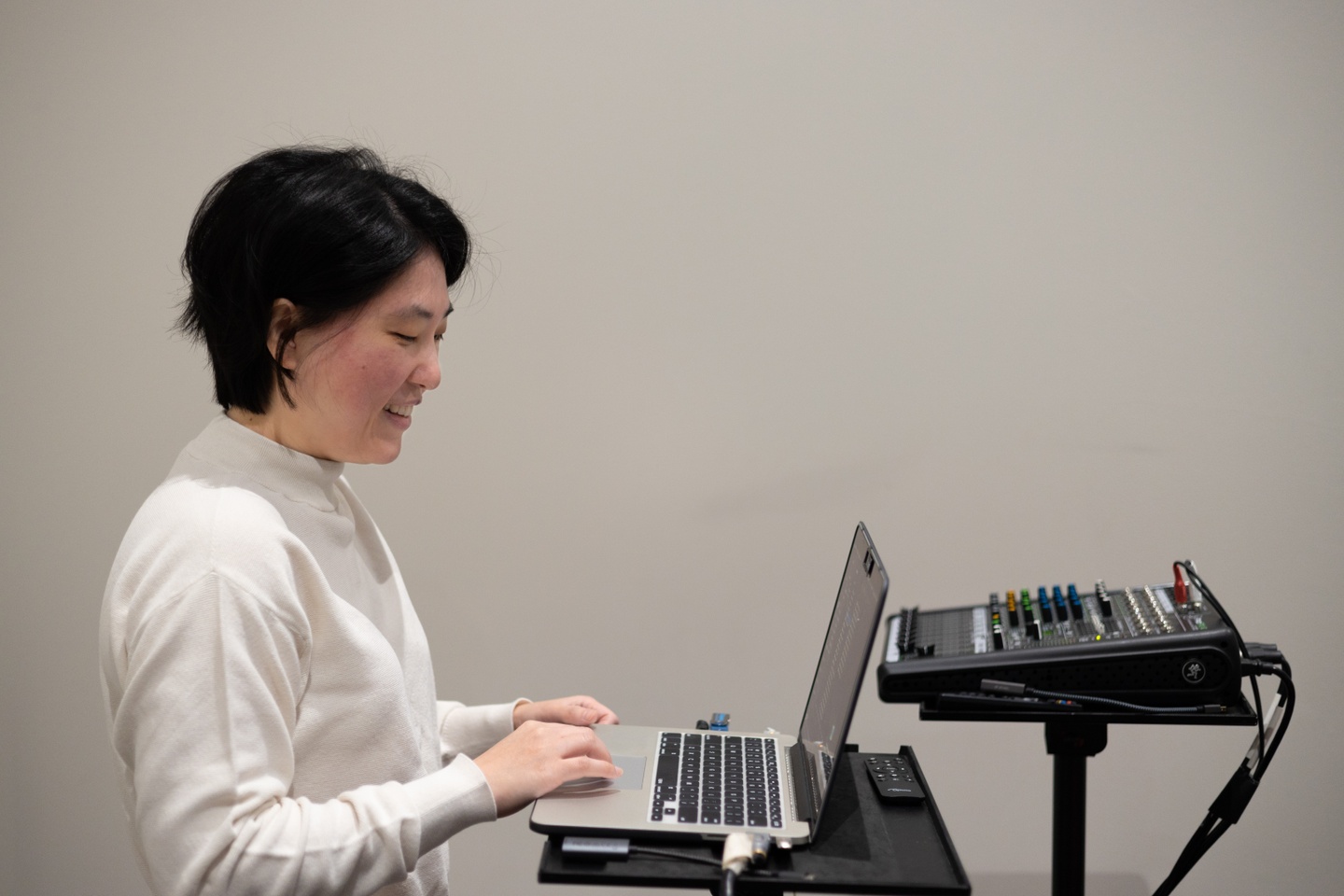Q&A with Seulki Seo
Seulki Seo earned her BFA from Otis College of Art & Design. Seo was born in Korea and spent time in Israel before moving to the U.S., where she’s lived in California, New York, and Missouri. With a background in painting, Seo explores the intersections of art, technology, and ecology through mixed-media.
Seulki Seo, Sam In Sung Ho (삼인성호) in the Froward Women Series, 2022-23, single-channel video, color, sound, 7 min 15 sec.
Seulki Seo in her studio. (Photo: Caitlin Custer)
What is your thesis project like?
It is a video installation that exposes underlying phenomena across politics, society, and culture. My body of work is exploring the interdependency of technology, ecology, and humankind, specifying othering as one of the driving mechanisms of the triad.
You’ll walk into a dark room and see three TVs in front of you, which I call the future. Behind you, there are five smaller screens, which I call the past. And the present is where you are. I find that we often think of time on a linear, horizontal axis. I see time as a spiral. So the way I’ve placed these things in the room, you can really only focus on one thing at a time.
In the past, if there was a really big sculpture, people would be curious. They’d want to see it, spend time near it, wonder how a human made it. Now, if you see something really beautiful or something that amazes you, you take a selfie, post it, and start stimulating your dopamine. There are so many images pouring in every second … you’re not amazed by anything anymore. So I am thinking, “how could I react to this whole situation?” That’s what inspired me to create this setup.
The series is also about how I’m trapped in these relationships and have no agency. I want to raise questions and tackle issues in this area.
What will be on the screens?
One set of screens shows the installation submarine fiber optic cables and mining in the Democratic Republic of Congo. These show some of the processes necessary for the internet to exist, and how people and nature are being exploited for the sake of one tap.
The other set shows an animated, imagined future where giant totems appear in Los Angeles one day, out of thin air. People are scared and unsure of what to do. But someone decides to explore, and figures out that they work as a portal to other places.
Tell us more about the past screens and your thoughts behind “For the Sake of One Tap.”
I’ve spent a lot of time thinking about techno-colonialism. Footage of mineral mining for the manufacture of computer accessories, smartphone manufacturing processes, submarine optical fiber cable installation, construction of data centers, etc. reveals that the seemingly insubstantial digital world is in fact supported by massive physical entities. In this context, I identify that the subject who is otherizing is not a single entity, but a complex of transnational corporations, states, and individual stakeholders. The objects of othering are the people — particularly southern hemisphere and East Asian laborers — and nature that humans exploit to maintain the infrastructure. Finally, the involuntary participants in Othering are all computer and Internet users, especially their bodies.

Seulki Seo in her studio. (Photo: Caitlin Custer)
And what is the significance of the totems?
I discovered that the term “misogyny” comes from a play, Swetnam the Woman-Hater, and that it was published in reaction to a pamphlet called The Arraignment of Lewd, Idle, Froward, and Unconstant Women by Joseph Swetnam. Unfortunately, the descriptions of women — lewd, idle, and unconstant — are familiar even in the 21st century. The only word I could not relate to, because it’s no longer commonly used, was “froward,” which turns out to mean “habitually disposed to disobedience and opposition.” Witnessing a deeply rooted legacy of hatred towards women and simultaneously reflecting on the current situation in which women find themselves, I was compelled to react as the anonymous playwright did in the 1600s. Acknowledging the history of women and minorities’ struggles in the U.S., I decided to claim the word “froward” to suggest another political identity for women, similar to how the LGBTQ+ community has reclaimed the word “queer.” The totem, which is called Froward Women, is based on this research.
How did you come to be an artist, and what’s important to you about creating?
I’m a non-medium-specific artist. I’ve worked in sculpture, painting, AI, animation…this time I was focused on video. I wanted to talk about postcolonialism, technocolonialism, the past, present, and the future through time-based media.
I feel like the smartphone has changed my sensory interaction and reaction in the world. It’s changed my brain. I realized that it’s probably not just me, it probably affects everybody. As an artist, I want to respond to these phenomena as well.
What do you hope someone experiences when they step into the room and see your installation?
I hope people will think about the society that they want to live in. If you are not thinking, then somebody else will think for you and will decide what to do. I hope that people have a moment to think about it.
Seulki Seo reflected on the scope of her practice, time at WashU, and thesis project leading up to the MFA in Visual Art thesis exhibition. This is an edited transcript of Seo’s words as told to Caitlin Custer.



